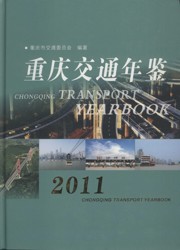一、《重庆交通年鉴》是反映重庆交通各方面发展情况的大型专业年鉴,是逐年编纂连续出版的资料性工具书。2011年卷(简称本卷)是继2007年创刊以来的第5部。全书100万字、126幅图片,反映2010年重庆交通的基本面貌、发展状况和取得的新成就、新经验以及出现的新问题。
二、本卷基本内容分为综合情况、动态信息、附属资料三部分。综合情况分设《彩页》、《特载》、《概况》3个类目,动态信息分设《交通基础设施建设》、《交通运输》、《交通管理》、《科技·教育·文化》、《党群工作》、《区县交通》、《先进集体·先进人物》7个类目,附属资料分设《大事记》、《政策法规选编》、《统计资料》、《附录》4个类目。为突出年度特点,本卷特设《部市领导共商加快重庆交通运输发展》、《全面完成十一五规划目标 加快建设长江上游地区综合交通枢纽》、《全面提高交通党的建设科学化水平为加快建设长江上游地区综合交通枢纽提供坚强保障》、《谋通衢广陌之大道一重庆“二环八射”高速公路网全面建成纪事》、《交通得到巨大发展是重庆“十一五”一大亮点——重庆交通“十一五”综述》等专栏。全书结构一般分3个层次:类目、分目、条目。基于内容特点,《特载》、《大事记》、《政策法规选编》和《先进集体·先进人物》只设2个层次。全书注重体现专业特点、时代特征和年度特色,力求在充分反映成绩和经验的同时,如实反映存在的问题和不足。
三、本卷力求扩大信息量,延展信息覆盖面,特在《概况》、《交通基础设施建设》、《交通管理》、《附录》等类目中,收录了有参考、研究价值的资料,以便于读者了解重庆基本情况、古近代交通、现代综合运输,对比研究重庆与其他省、自治区、直辖市交通发展情况,借鉴世界发达国家交通建设和管理的先进经验。
四、本卷注重图片资料搜集,分彩页和内文配图两种形式编录,力求全书图文并重。彩页以专题化、系列化的形式,重点反映重庆交通大事、要事和主要建设成就;内文配图以文系图,形象直观地补充反映相关内容。
五、本卷稿件和资料由重庆市交通委员会机关各处(室)、委属各单位、各区县(自治县)交通局(委)、大型交通企业和有关交通机构提供,并经各单位(部门)领导审核和保密审查。主要统计数据以市交委业务主管部门提供的统计资料为准,未署名的条目、图、表均由《重庆交通年鉴》编辑部或相关单位提供。
六、本卷注重提高实用性,刊载有《重庆市地图》、《重庆市公路现状图(2010年底)》、《重庆市航道港口发展规划图(2009-2020年)》、《综合运输大通道和全国性综合交通枢纽示意(五纵五横图)》、《国家快速和普通铁路网示意图》、《国家高速公路网现状图》、《沿海港口和内河航道网示意图》、《民用运输机场布局和主要航线示意图》。
七、为免累赘,本卷中凡直书月、日而未写年份,即为2010年;数据增加或减少多少未说明与某一年份比较,即为《年鉴》记载当年(2010年)与上年(2009年)比较。
八、本《年鉴》书前列有中英文目录。
九、为行文简洁,对常用机构采用通用和规范简称,并在目录前特设《有关机构(单位)全称简称对照表》,增加“常用缩略语注释”。
Ⅰ.Chongqing Transport Yearbook is not only a large-scaled professional yearbook that reflects the development invarious aspects of the transportation of Chongqing,but also a reference book which is compiled annually and publishedcontinuously.Volume 2011(short for Yearbook) is the fifth edition since the publication of Volume 2007.It includes 1,000,000words with about 126 pictures that reflect the basic situation,development status,new achievements,new experiences andnew problems in the transportation of Chongqing in 2010.
Ⅱ.The content of Yearbook covers three aspects named General Information,Trends Information,and SubsidiaryInformation.In the first part,there are three columns which are Exclusive,General and Comprehensive TransportationSystem Reform.In the second part,there are seven columns,Infrastructure Construction in Transportation,Transportation,Transportation Management,Science&Technology·Education·Culture,CCP Work,Transportation in Districts and Counties,and Advanced Collectivities·Advanced Persons included.In the last part,there are four columns setting as Memorabilia,Extracted Policy and Regulation,Statistics Data,and Appendix.In order to highlight the feature of this year,Yearbook sets upsome special coulumns.For example,The Leaders of the City and the Sector Discuss Ways to Accelerate the Development ofChongqing Transportation;Complete the 11th Five-Year Planning Goals,and Accelerate the Development of TransportationHub in the Upper Yangtze River;Improve the Level of Transportation Construction Guaranteed the Rapid Construction ofthe Transportation Hub in the Upper Yangtze River;How to Make the Convenient Transportation-Stories of the 'EightExpressway and Two Ring Road'Construction in Chongqing;and The Huge Development of the Traffic Is the Bright Spotin the Period of '11th Five-Year Plan' of Chongqing.The structure of the Yearbook can classify three levels:Column,Sub-column and Entry.Because of the features and the content,Exclusive,Memorabilia,Extracted Policy and Regulation,and Advanced Collectivities·Advanced Persons have only two levels.This Yearbook focuses on the professional features,times and yearly characteristics,and fully reflects the achievements and experiences as well as the problems and shortages.
Ⅲ.Yearbook strives to expand the scope and the coverage of information.Particularly,the collected information in thecolumns of General,Infrastructure Construction in Transportation,Transportation Management and Appendix,is worthy ofbeing referenceed and researched,which can help readers to understand the basic situation,ancient and latter-day transportand modernintegrated transportation in Chongqing,compare to other municipalities and autonomous regions to study transportdevelopment,and also learn advanced experiences on transport construction and management from developed countries.
Ⅳ.Yearbook emphasizes the collection of pictures.The whole book is illustrated with color pages and pictures.In colorpages,major events,important events,and major construction achievements in transportation of Chongqing are reflected byparticular topics in series.Articles are inserted with captioned pictures to show the content more directly and visually.
Ⅴ.The articles and information in Yearbook are provided by various divisions of Chongqing Transport Committee andother units which are directly under its administration,as well as Transport Bureaus(Transport Committee) in every districtsand counties(autonomous counties).Yearbook has been reviewed by the leaders of each unit(division) and passed theconfidential audit.The major statistics data is provided by the Departments of Chongqing Transport Committee.The unnamedentries,pictures,and forms are all provided by Chongqing Transport Yearbook.
Ⅵ.Yearbook attaches much importance to practical application,and carries with Chongqing Transportation Map(untilthe end of 2010),Chongqing's National Highway Network Map of "11th Five-Year Plan",Chongqing's Port PlanningMap,and Chongqing Navigation Channel Map.
Ⅶ.To keep concise,if the time only has month and day without year,it means 2010;the increase and decrease of thedata is gotten by comparing 2009 and 2010.
Ⅷ.The Content of Yearbook is written both in English and Chinese.
Ⅸ.In order to keep compact,the common and standard abbreviations of the institutions are adopted.The ComparativeTable on Full Title-Abbreviation Name of the Relative Organizations(Units) is setted in front of Content.
